Tuesday, October 17 2023
In the words of Tom Massie, son of the late George "Buzzard" Massie who founded Gold Prospectors Association of America... "my favorite way of prospecting is the way that gets me gold." Suction dredging with a wetsuit can be quite lucrative— not only from the material you suck up but there's also the chance of picking SIZES OF GOLD:
Saturday, December 05 2020
With gold prices on the rise, you might be wondering if now is a good time to sell some of the gold you’ve found over the years. And if Gold dust consists of flour, fines and flakes. This is the stuff most prospectors find as a result of panning, sluicing and dredging. This form of gold is probably the lowest value because it will have the most impurities. Small nuggets start at about 1 gram and are a step up from gold dust in value. Medium nuggets, on average, weigh up to 31 grams or 1 troy ounce. Large nuggets are defined as weighing 1 troy ounce or more. Larger nuggets usually command higher prices, and could be considered museum quality. Gold in quartz is usually a collector’s item or a museum piece, therefore, prices widely vary. Keep in mind, though, that even nuggets that appear to be pure gold are not. They will have impurities embedded and blended into the matrix. There is no such thing as 100% pure gold from nature. In fact, in North America, the average purity for prospected and mined gold averages 60% - 85%. The impurities in natural gold consist of metals such as silver and copper and other minerals that have combined with gold on a molecular level. Tests, referred to as an “assay” must be performed to accurately measure the purity of gold. Some jewelers and pawn shops can analyze your gold to determine purity with an XRF gun (X-Ray Fluorescence); expect to pay a charge for that service. The majority of gold bought and sold from small-scale prospectors include: private buyers (some advertise on eBay, Craigslist, and other online sites) pawn shops, independently owned jewelry stores that craft and repair their own jewelry, museums looking for unusual specimens or rare nuggets, and refiners. Most refiners are contracted by large gold mining operations, but some smaller refiners will purchase gold from prospectors in any form or mesh size. An internet search will reveal refiners that will buy from individuals. If you want to sell your fine gold or nuggets, there are a few things to do first. You may not get a totally accurate assessment of your gold’s value, but you’ll at least have a ballpark estimate. Do NOT melt your gold. Keep it in its original form.
When you make contact with potential buyers who specialize in raw and natural gold, be sure to ask about and understand their procedures and policies and payments. Ask how your gold will be assayed and how the purity is determined. If you are shipping your gold to a buyer, understand their requirements for packaging and shipping, insurance, and other safeguards. Some buyers pay for the testing and shipping, others pass along the costs to the seller. Remember that buyers have costs and will not pay 100% of the spot price. The exception to this would be if you have museum specimens or very large nuggets. In those instances, buyers will pay more than the spot price. Be patient and shop around to not only get the best price, but to find a buyer who you can work with now and in the future. Get recommendations from fellow prospectors, or clubs such as GPAA (Gold Prospectors Association of America). If possible, make your first transaction with a new buyer a small one to assess your experience and satisfaction with the overall sales process. When you feel you have had a successful first transaction, you’ll feel confident you can continue that relationship in the future. If you've not yet found your first gold, get Alaska paydirt here. Monday, January 20 2020
The 2020 GPAA Gold & Treasure Show circuit is planned to be better than ever this year! With $110,000 in prizes, several dozen vendors demonstrating equipment, informative Saturday show hours 10 am - 5 pm and Sundays 10 am - 4 pm in these cities: • Pomona, CA: February 15-16 Visit the GPAA website or their Facebook page for more details and to buy your advance $5 adult tickets; kids 12 and under plus military and veterans with ID are FREE. General admission at the door is $10. If you can, make a family road trip out of attending one or more of the shows this spring. In addition to the show itself, each city has fun touristy things to do, and if you're a GPAA member, you can prospect on nearby mining claims. Whether you’re a family with kids or a lone enthusiast, a GPAA Gold & Treasure Show is your one-stop-shop for all of your gold prospecting and treasure hunting wants and needs. By attending a show, you're sure to have a blast, meet interesting people, find new tools, and learn new tricks of the trade. All of that is enough to make you hollar Eureka! Friday, February 01 2019
Did you know... there is actually more gold still out there waiting to be found today than the old-timers ever
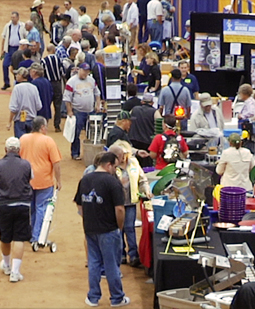 recovered way back in the 1800s gold rush era? And did you also know that attending a GPAA Gold and Treasure Show (Gold Prospector's Association of America) is a great place to get started on your modern day treasure hunt?! recovered way back in the 1800s gold rush era? And did you also know that attending a GPAA Gold and Treasure Show (Gold Prospector's Association of America) is a great place to get started on your modern day treasure hunt?!Browse the show floor to find dozens of leading worldwide manufactures and local vendors demonstrating the latest and greatest gold mining and metal detecting equipment, attend free seminars, ask questions of the pros, and enter to win thousands of dollars in door prizes. Pick up a pan for the first time or hone your skills at the panning zone, where skilled instructors will help you recover gold, for free. Keep all the gold you find!
Saturday show hours 10 am - 5 pm and Sundays 10 am - 4 pm in these cities:
Visit the GPAA website for more details and to buy your $5 adult tickets; kids 12 and under plus military and veterans with ID are FREE. If you can, make a family road trip out of attending one or more of the shows this spring. In addition to the show itself, each city has fun touristy things to do, and if you're a GPAA member, you can visit nearby mining claims.
Whether you’re a family with kids or a lone enthusiast, a GPAA Gold & Treasure Show is your one-stop-shop for all of your gold prospecting and treasure hunting wants and needs. By attending a show, you're sure to have a blast, meet interesting people, find new tools, and learn new tricks of the trade. All of that is enough to make you hollar Eureka!
Nugget of News Blog Monday, January 29 2018
Make plans this spring to attend a Gold Prospectors Association of America (GPAA) Gold & Treasure Show! No matter your age or experience level, the expos offer something for everyone and provide the best opportunities to learn new skills, see product demos, and rub elbows with some of the most respected miners and metal detectorists in the business!
Nugget of News Blog Sunday, January 29 2017
Make plans this spring to attend a GPAA Gold & Treasure Show! Whether young, old, or in the middle, the expos offer something for everyone and provide the best opportunities to learn new skills, see product demos, and rub elbows with some of the most respected miners and metal detectorists in the business! Also on the show floor are panning troughs for both kids and adults where you can learn new techniques— and keep all the gold you find! Saturday show hours 10 am - 5 pm and Sundays 10 am - 4 pm in these cities:
Visit the GPAA website for details and to buy your $5 adult tickets online ($10 adult admission at the door; kids 12 and under plus military and veterans with ID are free). Saturday, October 01 2016
Gold Prospectors Association of America (GPAA) has announced its Fall 2016 schedule of Gold & Treasure Shows for Nashville, Dayton, and Concord! Whether you’re a newbie prospector or detectorist, or have been mining Children 12 and under are FREE, so be sure to bring the kids and the whole family can pan for gold together—and keep all the gold you find! Adult pre-sale admission purchased online is $5 until the Friday before each show, or $10 at the door. Active military members and veterans with ID are FREE. Saturday shows run 10 am - 5 pm and Sunday 10 am - 4 pm. Thousands of dollars in door prizes are given away each day—detectors, pans, sluice boxes, you name it! All you have to do is show up and you could be leaving with a brand new piece of top of the line prospecting equipment. Mark your calendars for:
Visit the GPAA website for more details and online registration. Wednesday, January 21 2015
Mark your calendars for these dates and cities:
Visit the GPAA website for more details and online registration. See you there! Monday, January 19 2015
PI (pulse induction) detectors work a bit differently than the more common VLF (very low frequency) detectors by putting magnetic field energy into the ground and then switching off and waiting a short period before they start to look for a response. This makes them better at handling ground mineralization than a VLF detector because during that short delay the magnetic response of iron trash minerals that you don't want to find dies out. VLF detectors do not as easily cancel out ground mineralization the way a PI metal detector can do. Kevin Hoagland, Executive Director of Development for the Gold Prospectors Association of America recently field tested the Garrett ATX Deepseeker. Below is an excerpt of Kevin's review: "My first impression of the ATX was that it's compact, heavy and built like a tank, and all connections are waterproof. Battery installation is simple. The ATX uses 8 AA batteries in two 4-battery drop-in packs and comes with an 8-slot AA battery charger. Not only does this detector come with a rugged case and carry bag, but also everything else you need to get out detecting. The units ships with the 20 inch mono coil already installed. It is also shipped with headphones that are screwed into the back of the unit. I slipped my arm into the adjustable cuff, and grabbed the control pod. There was no unnecessary torque on
As with most large PI detectors, the Garrett ATX Deepseeker Metal Detector is not light, and the waterproofing adds extra weight. Were it not for the ergonomic design, detectorists not accustomed to the weight of these machines might tire quickly. The supplied sling is easy to use, adjust, and offers a fair way to alleviate some of the weight, but I found it uncomfortable for long periods of use. Many avid detectorists use after-market harness systems, so you may want to check out those options if you plan to spend long days detecting. In the field, the Deepseeker performed exceptionally well. The unit demonstrated almost complete immunity to all but the worst hot rocks I encountered. The ground balance and multi-speed ground tracking worked great, but I found that I rarely used the ground tracking as the ATX handled most of the soil mineralization in the OFF position. The threshold was quick to respond to ground changes and a simple ground balance was all that was needed to bring the ATX back into maximum depth and sensitivity. The Iron Check works well, maybe even too well! I dig everything no matter what and I have had a very successful nugget-hunting career doing just that. I have found good targets under junk on many occasions. Be careful and mindful that gold, like junk, is where you find it and there is no law of detecting that states there will be no gold under junk! Regardless of your level of detecting expertise, it will take some time to get comfortable with all the functions and navigating the menus of the ATX. With multi-button presses to access some functions, it's important to take time to learn the machine well beyond the quick-start level. Overall, Garrett has created a PI detector that is extremely well made with solid functionality. The ATX offers great value for your dollar. Garrett has again carved a niche in the metal detector market, and the ATX perfectly has met the needs expressed by detectorists worldwide..." You can find Kevin's complete field test review on pages 16-19 of the November/December 2014 issue of Gold Prospectors Magazine, or download the .pdf here. You can also get more information and watch a video of the Garrett ATX Deepseeker Metal Detector on this website. Sunday, January 11 2015
"... The Desert Fox ships in an Action Packer case that is the storage, transport, and water container unit. It provides excellent protection for the Fox while giving you a true compact recirculating unit that can be transported easily. Unpacking the container was simple and for those of us that spend little time looking at the way something comes out of a container, the manufacturer has included a photo in the manual to show you how to repack the unit so it's back to being travel-ready in just a few seconds. In the container you will find:
Setup takes just a few moments. The wheel frame is a single point A-frame that sits perfectly in place in the container and allows you a stable, easy-to-set-up base for the spiral unit. The A-frame construction also allows the unit to be set up directly in a stream. Stand the A-frame in the container, lift the drive unit to a beginning angle, slide the double-wall wheel into the slot on the drive motor, attach the spray bar, fill with water, hook up to a 12-volt power supply (not included), and after a couple of fine tuning adjustments, the Desert Fox is ready to start running your concentrates. Total time from cased to running is about two minutes! The A-frame mounted drive motor allows you to easily make small adjustments to the angle of the wheel. This ease-of-use factor can become critical when running materials that require more precision. Water flow is controlled by a single-point knob on the spray bar assembly, and the speed control is located on the back of the unit. These 3 adjustments are all you need to ensure efficient gold recovery. Before first use, be sure to clean with a good quality dish washing soap to remove all the manufacturing oils (mold-release agents from the plastic parts). Do NOT use a citrus-scented soap because the scent is derived from oils, which is exactly what you are trying to remove. Use hot soapy water and a non-abrasive pad. Spiral panners work in reverse of traditional hand panning. Instead of gravity separating gold from concentrates with the heavies sinking to the bottom of a pan, a spiral machine uses speed, water, and the angle of the spiral wheel to keep lighter material in the bottom of the wheel, while the heavier black sand and gold is brought up the leads. When set correctly, the sands drop off at the last moment and only gold is moved through the center of the unit and recovered in the cup.
Starting with the water first, find the lowest water pressure that will clean the light material from the leads as it climbs up the pan, adjust the angle and speed as needed so the heavy sands drop off at the right spot and you're ready to start processing your concentrates. After completing the basic setup, I adjusted the speed to keep the unit tuned in to variations in the types of material I ran. There are two models of the Desert Fox— a constant speed ($339) and a variable speed ($359). Since the difference in price is just $20, I highly recommend the variable speed model. The Desert Fox is a straight-forward and simple spiral wheel system that recovers gold efficiently, and has been manufactured by Camel Mining since 1969. It is compact, weighs about 10 pounds, and is ideal for carrying into the field. Gold recovery is exceptional and the learning curve is short..." Click here to learn more about the Desert Fox Spiral Panner on this website. Click image to download .pdf of field test review. Monday, September 01 2014
In the spring of 1859, flakes of gold were found in Clear Creek, a tributary of the South Platte River in north central Colorado. Some prospectors were happy finding rich gold dust, but John Gregory w Within two months of Gregory’s initial gold discovery, 900 fortune-seekers were living in log shanties and tents. By the following summer, the population had swollen to 10,000. In no time, businesses and mills were thriving and the area became the leading mining center in the Kansas Territory. At this time, Colorado wasn’t yet a state, but its prominent place in mining history was already secured. Between 1859 and 1918 (considered by the National Register of Historical Places to be the area’s “period of significance”), the total gold output was $83,364,157! Most of this was in the form of placer gold, which was extracted with pans and sluices. This “easy” gold played out within the first five years of discovery, and by the end of 1863, most work had shifted to hard rock mining. The promise of riches continues to lure people to Central City today, but it’s not so much to find gold— but to gamble. Limited stakes gaming was legalized in 1991, and has made this area an important destination once again. Gambling was big business here in the 1880s, drawing the likes of Doc Holliday, and even Soapy Smith all the way from Alaska. The downtown core is now a National Historic District, and casinos reside in many of the restored historic buildings. Much of the beautiful and original woodwork, ceilings, and ornate furnishings date back to the 1870s. A scenic loop drive in the hills above the town is the place to find gold rush cemeteries, abandoned mines, headframes, and many other mining relics. Take a Walk The best way to learn more about Central City’s gold rush and admire its architecture at the same time is to stop at the Visitor Center on Eureka Street for a walking tour map. Choose from several self-guided walking tours, depending on your interests. Many of the town’s most magnificent buildings are in downtown, whereas Victorian residences are located outside of the business district. No matter how much ground you want to cover on foot, keep in mind you’re above 8,000 feet in elevation here, so pace yourself. Some buildings are open for guided tours (admission charged) but even if you don’t peek inside, you’ll get a good sense of the town’s history right from the street. If you want to shake hands with one-armed bandits or play poker at any time during your walk, you’ll find a chance to meet Lady Luck every step of the way.
In April of 1873, President Ulysses S. Grant came to see his friend Henry Teller. To impress the president, mine owners decided to lay 26 ingots of solid silver to make a path to the entrance to the Teller House so President Grant wouldn’t have to dirty his boots when he stepped from his carriage. Those wealthy citizens also had an ulterior political motive. At the time, Congress was debating whether gold or silver should back the dollar. Legend has it that Grant became angry when he saw the silver bars and walked up the boardwalk instead of on the silver path so as not to show favoritism. As we know, gold eventually won. The grand opening of the Opera House in 1878 (next door to the Teller House Hotel) started a tradition of community theatre, ranging from opera to vaudeville. Buffalo Bill Cody performed here as well as P. T. Barnum’s circus. The Opera House is known for its elaborately frescoed ceiling and perfect acoustics. In addition to Central City’s very popular Opera Festival held each summer, performances are held year round in this beautifully restored 550-seat theatre. The Opera Association also owns the Williams Stables building on Eureka Street. Initially constructed in 1876 for the use of Teller House guests, the building was purchased a few years later by Sheriff Dick Williams and his son. It was from here that a Stanley Steamer automobile could be had for hire— quite an achievement back in the day! Many of the Main Street establishments are identified by “blocks” and named for their original builders. In addition to the Teller House Hotel, Henry Teller also built the Teller Block for $6,000 in 1874. The upper floor was purchased a few years later by the Independent Order of Odd Fellows, which retained ownership until the 1990s. The Mullen Block was completed in 1874 by Thomas Mullen. Originally a drug store and clothing store, the Elks Lodge bought the building in 1902. The Harris Block was built in 1875 by Robert Harris and was home to the New York Store Mercantile that sold dry goods, clothing, and furnishings. Gold in Them Thar Hills The scenic forested hills above town offer evidence of the thousands of mining claims that placed Central City and the surrounding area in the history books. When you’re ready to take a short loop drive, the helpful staff at the Visitor Center will point you in the right direction. The route is mostly a well-maintained dirt road that takes you past headframes, abandoned mines, and sites of once thriving communities. Nevadaville is one such mining camp that 1,200 gold seekers used to call home. Along the route you’ll see the Coeur d’Alene Mine. Originally opened by Robert Cameron in 1894, the shaft reaches some 700 feet into the depths of Gunnell Hill. Records indicated that in 1915 this mine employed nine men who earned from $3-$4 per day. You’ll also see the shaft house of the Boodle Mill. Because of the serious safety hazard posed by abandoned mines, trespassing laws are strictly enforced. Although tempting to explore, keep away from old mines and tailings to avoid accidents.
The loop drive also takes you through the “cemetery district.” Many stories are told through the memorials and headstones. Harsh weather, less-than-clean water, mining accidents, and few physicians were the norm during the gold rush. So were epidemics of scarlet fever, diphtheria, and the Spanish flu. Sadly, you’ll notice that a large number of children are interred within the cemetery fences. When you visit, please remember these sites are historical grounds, but are also still in use today. The Gilpin County Historical Society also holds an annual “Cemetery Crawl.” "Oh My Gawd Road" After getting your fill of gold rush history and gambling, a popular route leading out of Central City to Idaho Springs takes about 30 minutes. It isn’t quite as bad as its moniker, but it’s not for the faint of heart either. The “Oh My Gawd” Road (CR 279) is more dirt than pavement and wouldn’t be wise for drivers who don’t like narrow, twisty roads, but the mountain views make it worth it. Along the bumpy route you’ll pass the famous “Glory Hole” mine workings, drive through Russell Gulch, and see many more mining relics that attest to “The Richest Square Mile on Earth” in days gone by. IF YOU GO: Central City is located in the Rocky Mountains, only 35 miles west of Denver. With the newly opened, Central City Parkway, visitors can reach Central City 12 minutes after exiting off of I-70 at exit 243. The Central City Visitors Center is located at 103 Eureka Street, at the northern end of Main Street in the old Wells Fargo Building. Articles and photos by Denise Seith. This article first appeared in the May 2014 issue of Gold Prospectors Magazine, published by the Gold Prospectors Association of America (GPAA). Wednesday, January 01 2014
Mark your calendars to attend a Gold Show in 2014! Gold and Treasure Expos sponsored by the Gold Prospectors Association of America (GPAA) are open to the public. Admission is $5 for adults; free for kids under 12. Each paid attendee will receive a 14 inch GPAA Gold Catcher Gold Pan and a copy of Gold Prospectors, the GPAA’s national magazine. Also, the first 100 paid attendees will receive a free vial of real gold!
2110 Frear St. (541) 957-7010 Lancaster, CA 93536 (661) 206-0427 9777 Las Vegas Blvd. South Las Vegas, NV (866) 796-7111 110 9th Ave. SW Puyallup, WA 98371 (253) 845-1771 ALSO MARK YOUR CALENDARS for the... 2014 Gold Prospecting & Mining Summit After a hiatus last year, this Summit returns to the Eldorado County Fairgrounds and features 80 booths with the latest in prospecting and mining equipment. Sponsored by ICMJ's Prospecting and Mining Journal, a team of writers and experts will be on hand to provide you with the information you need to succeed at gold prospecting and gold mining. Lecture topics include:
And back by popular demand... Two Additional Days of Hands-on Training! Admission is $5 at the door. Fairgrounds charges $5 parking per day. No pre-registration required for the Mining Summit, but pre- registration is a good idea for the Hands-on Training classes. |
|
Nugget of News Blog |






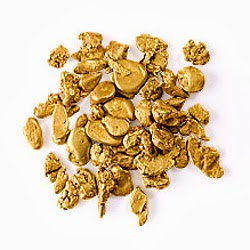 nuggets out of a crack in the bedrock.
nuggets out of a crack in the bedrock. 
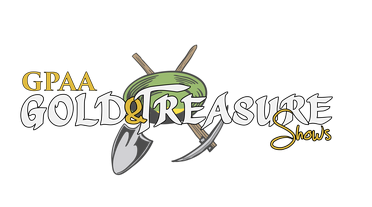 seminars, and 100 feet of gold panning troughs salted with real gold (keep all you find!), you won’t want to miss bringing the family to a weekend show sponsored by Gold Prospectors Association of Amercia. Eleven shows are to be held across the country in 2020.
seminars, and 100 feet of gold panning troughs salted with real gold (keep all you find!), you won’t want to miss bringing the family to a weekend show sponsored by Gold Prospectors Association of Amercia. Eleven shows are to be held across the country in 2020.
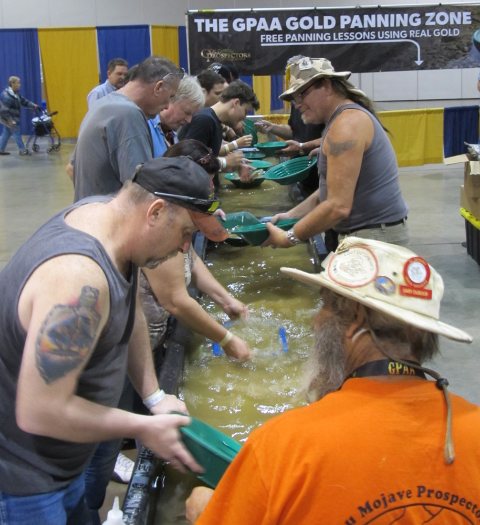
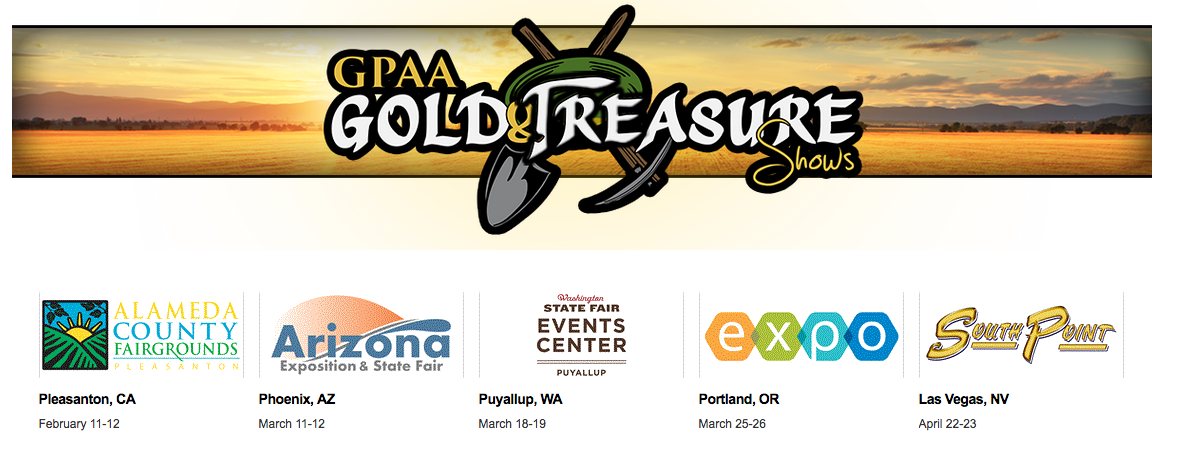
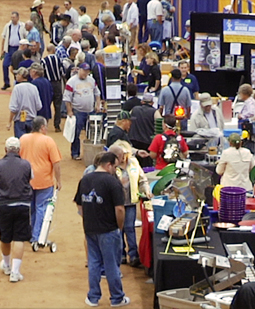 and metal detecting for years, these three shows offer a fun opportunity to rub elbows with some of the best in the business. In addition to browsing the show floor to find the latest and greatest equipment and supplies, meet Kevin Hoagland, host of Gold Trails.
and metal detecting for years, these three shows offer a fun opportunity to rub elbows with some of the best in the business. In addition to browsing the show floor to find the latest and greatest equipment and supplies, meet Kevin Hoagland, host of Gold Trails.  If you've not yet attended a GPAA (Gold Prospectors Association of America) Gold & Treasure Show, the coming months provide an opportunity to rub elbows with some of the best prospectors and manufacturers in the business! Browse the show floor to find the latest and greatest gold mining and metal detecting equipment, see product demos, attend free seminars, ask questions of the pros, and enter to win door prizes. Weekend shows run 10 am - 4 pm. Presale admission is $5 by registering online or $10 at the door.
If you've not yet attended a GPAA (Gold Prospectors Association of America) Gold & Treasure Show, the coming months provide an opportunity to rub elbows with some of the best prospectors and manufacturers in the business! Browse the show floor to find the latest and greatest gold mining and metal detecting equipment, see product demos, attend free seminars, ask questions of the pros, and enter to win door prizes. Weekend shows run 10 am - 4 pm. Presale admission is $5 by registering online or $10 at the door.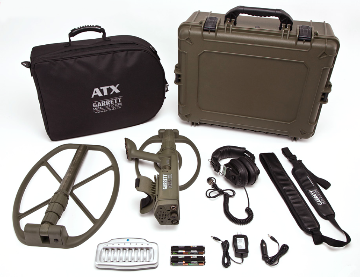
 my wrist, which gave it a perfect fit and feel, and allowed me to work all of the control buttons easily with my thumb. I pushed the unit out in front of me a bit and turned on the power switch, which is located on the back of the unit. The Garrett ATX Deepseeker Metal Detector goes through its startup and self-diagnostic test. Every light on the control pad comes on and unit emits several different sounds before settling into a comfortable, but high, threshold. This is not a turn-on-and-go detector. Either read the entire owners manual before you go out hunting, or at least read the first two pages of the manual— page 1 is the Quick Start Guide and an explanation of how to access the functions of the ATX quickly, and page 2 shows you where to find more information concerning those functions.
my wrist, which gave it a perfect fit and feel, and allowed me to work all of the control buttons easily with my thumb. I pushed the unit out in front of me a bit and turned on the power switch, which is located on the back of the unit. The Garrett ATX Deepseeker Metal Detector goes through its startup and self-diagnostic test. Every light on the control pad comes on and unit emits several different sounds before settling into a comfortable, but high, threshold. This is not a turn-on-and-go detector. Either read the entire owners manual before you go out hunting, or at least read the first two pages of the manual— page 1 is the Quick Start Guide and an explanation of how to access the functions of the ATX quickly, and page 2 shows you where to find more information concerning those functions.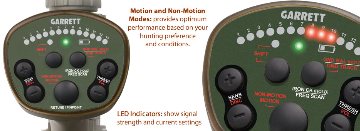 There are 5 major functions that are completely user-adjustable: Mode, Sensitivity, Threshold, Volume, and Ground Balance. Are functions are easy to adjust with a basic understanding of the ATX and more tunable as you become more proficient. Secondary functions include iron check, tracking, discrimmination and frequency shifting, to name only a few.
There are 5 major functions that are completely user-adjustable: Mode, Sensitivity, Threshold, Volume, and Ground Balance. Are functions are easy to adjust with a basic understanding of the ATX and more tunable as you become more proficient. Secondary functions include iron check, tracking, discrimmination and frequency shifting, to name only a few.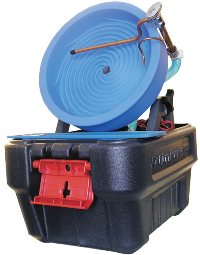
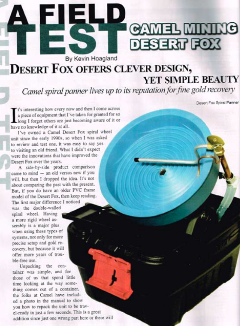
 as determined to find the source. For months, the Georgia native followed North Clear Creek upstream from the present-day city of Golden, and on May 6, 1859, made the first lode discovery in the Rockies! Gregory sold his two claims for $21,000 a few months later and left the area, but his name carries on. “Gregory Gulch” is located between the towns of Central City and Black Hawk. The Gregory Mining District encompasses these towns plus several other mining camps, and as a whole, this area is referred to as "The Richest Square Mile On Earth.” Central City takes it name from being “central” to all the mining activity.
as determined to find the source. For months, the Georgia native followed North Clear Creek upstream from the present-day city of Golden, and on May 6, 1859, made the first lode discovery in the Rockies! Gregory sold his two claims for $21,000 a few months later and left the area, but his name carries on. “Gregory Gulch” is located between the towns of Central City and Black Hawk. The Gregory Mining District encompasses these towns plus several other mining camps, and as a whole, this area is referred to as "The Richest Square Mile On Earth.” Central City takes it name from being “central” to all the mining activity. One of the most notable buildings in downtown is the 150-room Teller House Hotel. Located on the corner of Eureka and Pine Streets, it was built in 1872 at a cost of $87,000, plus another $20,000 to furnish. From its non-descript exterior, you’d never believe that the Teller House was once considered to be the most elegant hotel between Chicago and San Francisco. Financed largely by Henry Teller, who became the first senator from Colorado and later, Secretary of the Interior, it’s no longer used as a hotel but is the center for opera-related activities (Central City Opera House is next door).
One of the most notable buildings in downtown is the 150-room Teller House Hotel. Located on the corner of Eureka and Pine Streets, it was built in 1872 at a cost of $87,000, plus another $20,000 to furnish. From its non-descript exterior, you’d never believe that the Teller House was once considered to be the most elegant hotel between Chicago and San Francisco. Financed largely by Henry Teller, who became the first senator from Colorado and later, Secretary of the Interior, it’s no longer used as a hotel but is the center for opera-related activities (Central City Opera House is next door).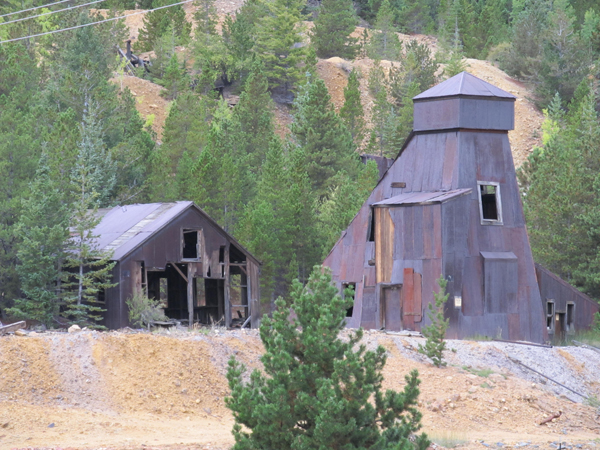 Known for their excellent stonework, the rock retaining walls visible in various places along the route were built by a very large population of Cornish miners. The walls were part of the former Gilpin Tramway, a 26-mile narrow gauge railroad that once looped around the gulches and through the surrounding communities. Sidings went to many of the major mines. Most of the retaining walls don’t use mortar, and were instead constructed using a dry-stack method. After more than a century, most of the rockwork is still holding up— no maintenance required.
Known for their excellent stonework, the rock retaining walls visible in various places along the route were built by a very large population of Cornish miners. The walls were part of the former Gilpin Tramway, a 26-mile narrow gauge railroad that once looped around the gulches and through the surrounding communities. Sidings went to many of the major mines. Most of the retaining walls don’t use mortar, and were instead constructed using a dry-stack method. After more than a century, most of the rockwork is still holding up— no maintenance required.